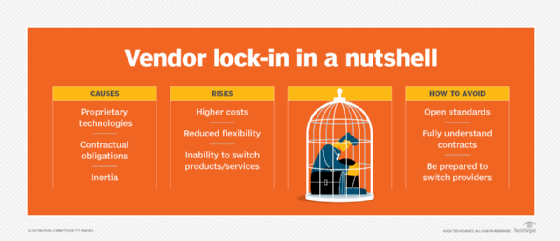What is vendor lock-in?
Vendor lock-in is a situation in which a customer using a product or service cannot easily transition to a competitor’s product or service. This can be a major problem, as it can limit the customer’s choices and make it more difficult to get the best possible value for its money.
The following are several factors that can lead to vendor lock-in:
- Proprietary technologies. If a product or service uses proprietary technologies that are not compatible with those of competitors, it can be difficult or impossible to switch to a different product or service without incurring significant costs.
- Contractual obligations. Some contracts may contain clauses that make it difficult or impossible to switch to a different provider. For example, a contract may require the customer to pay a termination fee if it switches providers before the end of the contract term.
- Inertia. Once a customer has invested time and money in a particular product or service, it may be reluctant to switch to a different product or service, even if it would be in its best interests to do so.
The risks of vendor lock-in
Vendor lock-in can have a few negative consequences for customers, including the following:
- Higher costs. If a customer is locked into a particular product or service, it may be forced to pay higher prices than it would if it was able to switch to a different provider. This is because the vendor knows that the customer has no other choice but to stay.
- Reduced flexibility. Vendor lock-in can reduce the customer’s flexibility to choose the best products and services for its needs. This is because the customer may be limited to using products and services from the vendor that it is locked into.
- Inability to switch. Vendor lock-in can increase the customer’s risk of being locked into a product or service that does not meet its needs. This is because the customer may be unable to switch to a different product or service without incurring significant costs.

How to avoid vendor lock-in
There are several things that customers can do to avoid vendor lock-in, including the following:
- Choose products and services that use open standards. Open standards are standards that are not controlled by any one vendor. This means that products and services that use open standards are more likely to be compatible with those of other vendors.
- Avoid contracts containing clauses that make it difficult or impossible to switch providers. Before signing a contract, be sure to read it carefully and understand all the terms and conditions. If there are any clauses that you do not understand, ask the vendor to explain them to you.
- Be prepared to switch providers. If you are not happy with the product or service that you are using, be prepared to switch providers. This may involve incurring some costs, but it may be worth it in the long run if it means that you can get a better product or service.
Vendor lock-in is a serious problem that can have a number of negative consequences for customers. By taking steps to avoid vendor lock-in, customers can protect themselves from these risks and ensure that they are getting the best possible value for their money.
See four best practices to avoid cloud vendor lock-in, and get to know the risk of hyper-converged vendor lock-in. Weigh the benefits of PaaS providers against lock-in risks, explore how to beat vendor lock-in with a cloud exit strategy and see five multi-cloud storage management mistakes to avoid, including vendor lock-in.
This was last updated in May 2023
Continue Reading About vendor lock-in














